Introduction
The benefits and compromises of owning a power catamaran are usually obvious for different consumers, depending on their circumstances, boating ambitions, and level of experience. However, a rapidly growing number of seasoned boaters are learning the joys of owning a catamaran and end up becoming firm catamaran supporters.
We have witnessed amazing changes to how families go boating together on a catamaran. For many families, the catamaran yacht has enabled their kids to join and bring their friends without overcrowding the boat. Guests do not have to be seasoned yachties to enjoy the day in the stable and protected cockpit. While entertaining can be done with style and without stress.
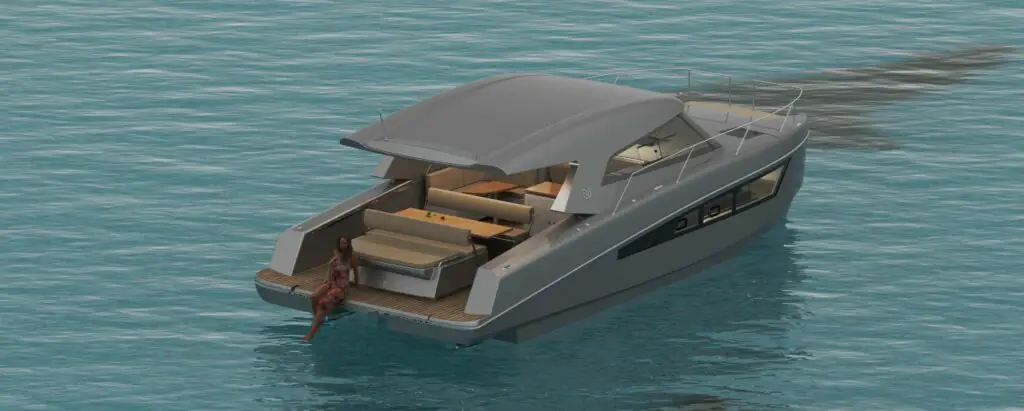
The most compelling argument of all must be this: seasoned monohull boaters are converting to catamarans by the truckload. Many converted former motor yacht owners are now passionate advocates of power catamarans. For experienced yachties demanding performance, the advantages are simply too great to ignore. It is rare to hear of any catamaran owners ever going back to a monohull. Once you become a catamaran owner, you are hooked for life.
“Why should I buy a power catamaran instead of a similar sized motor yacht?”
We are regularly asked by buyers “why should I buy a power catamaran instead of a similar-sized motor yacht”. Like everything, there are benefits and compromises to the power catamaran. Despite ourselves being firm Catamaran converts and lifetime believers, below we offer a balanced comparison of the pros and cons.
MONOHULLS
Advantages of Monohulls
A monohull, as the name implies, has just one hull. This is the most common type of hull design, but why? To produce a well-balanced comparison let’s start by investigating the benefits of monohulls:
- Slow roll period
- Many brands and builders to choose from
- More usable space below the waterline
- Familiar handling
Slow roll period
While monohulls roll back and forth far more than a catamaran, monohull fans will argue that the slow roll period of a monohull has a comforting effect.
There any many brands and builders to choose from as most builders still only produce monohulls. Whilst this trend is changing, 50+ years of composite boat building has been heavily monohull focused. This does mean that there is a far greater selection of vessels, designers and brands, and builders to select from.
More usable space below the waterline
Whilst the monohull comparably has less interior space, the wide waterline beam (width) allows for greater use of the internal hull height. This either enables builders to mount tanks and storage below cabin floors or to actually expand the cabin below the waterline. As a catamaran gains performance via its light displacement and narrow waterline beam, this is often not practical on a catamaran.
Familiar handling
Jumping from one boat to another will feel extremely familiar as the differences in handling between brands is minimal, with the exception of planning hull vs displacement hull. Focusing on planning hulls, however, you will quickly feel familiar jumping from one boat to another. On the contrary, the differences in handling from a monohull to a power catamaran are immediately apparent.
Disadvantages of Monohulls
Now that we have seen the advantages of a monohull, let’s analyze some disadvantages one might encounter while boating on a typical V-bottomed or deep-V motoryacht.
- Slamming
- Low stability
- Bow steering
- Rolling at anchor
- Significant bow rise
Slamming
Due to the wide flat hull shape required to get the monohull more quickly into planning mode, it can produce a rather bumpy ride when motoring through waves. Performance through waves can be significantly improved or diminished depending on the hull shape. For instance, a deep V hull will be more comfortable through waves than a shallow V. However, both are significantly outperformed by even the worst power catamaran designs.
Low stability
A monohull’s heel angle is directly affected by weight placement. Moving too much weight to port or to stbd will cause the vessel to heel. This is significantly noticeable when at anchor however even underway an incorrectly loaded monohull can dangerously heel. This can be overcome underway by the use of trim tabs. However, is best overcome by conscious weight placement and management.
Bow steering
Bow steering usually occurs when motoring at speed in a following sea or when passing another vessel’s wake. If you are inexperienced and do not know what is happening it can be quite frightening. Basically, the boat will suddenly and often expectantly turn hard in one direction while rolling hard in the opposite direction, despite your efforts to steer straight. Bow steering can be prevented with the installation of trim tabs. They can enable you to raise the bow up and out of the water when in a following sea. Trim tabs are not needed on a catamaran due to the natural separation of hulls’ bow steering.
Rolling at anchor
At times you will undoubtedly come across anchorages that aren’t completely flat. When this happens, monohulls, that rely on the weight of their COG (center of gravity) to be aligned below their COB (center of buoyancy) to keep them upright, will start to rock from side to side. Things roll around inside, plates go flying. It’s uncomfortable or sometimes impossible to cook, and only the hardiest of yachties will be getting any sleep.
While all of this is going on, at the next mooring ball, the power catamaran owners are sitting in their cockpits sipping sun-downers, barely noticing the movement, quietly getting tipsy before a long night’s sleep.
Significant bow rise
The degree of bow rise varies with monohull designs. However, for those of you unfamiliar with this term, bow rise is the tendency of a boat to point its bows up in the air before it gets into planning mode and then settles somewhat. This puts passengers through an uncomfortable, and sometimes unnerving experience whilst also exposing the vessel to a decreased level of stability and safety.
POWER CATAMARAN
Advantages of Power Catamarans
Whilst individual designs can vary by design and their usage, the benefits below are typically universal for most catamarans. In comparison to the equivalent length monohull a catamaran shall deliver the following advantages:
- Superior ride comfort
- Enhanced stability at anchor and underway
- Up-scaled cabins and interiors
- Larger single-level cockpit and saloon
- Significantly improved fuel consumption
- Drastically improved close-quarter maneuvering
Superior ride comfort
Catamarans experience slower deceleration through wave impact. This significantly reduces slamming through waves. This has been measured with accelerometers in like-for-like tests to have a 25% reduction in G forces when riding over waves.
Enhanced stability at anchor and underway
Due largely to their wider beam, catamarans have a remarkably higher righting moment compared to monohulls. This prevents them from rolling side-to-side when at anchor, and keeps them sitting level both underway and at rest. This is regardless of the placement of people or luggage, this also eliminates the need for catamarans to use trim tabs.
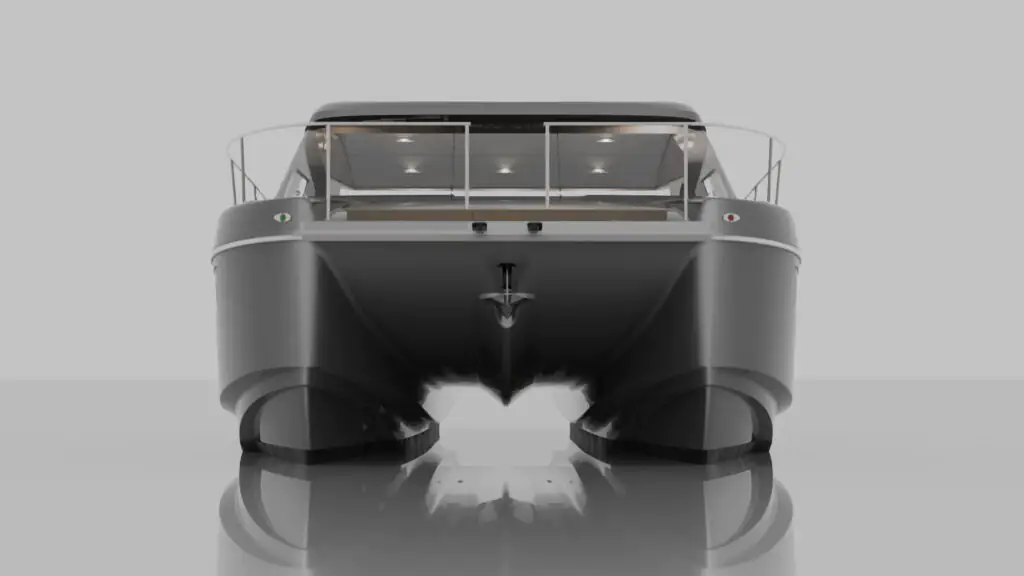
Up-scaled cabins and interiors
More interior volume, especially in power catamarans that carry their beam all the way forward. Even applicable in the smallest cats that usually have stand-up headroom in each cabin, unlike smaller monohulls. As a result of this increased volume, a power catamaran will always feel oversized – more fairly compared to a monohull 15-20% longer in length. A 35ft power catamaran for instance is more fairly matched against a 43ft motor yacht.
Larger single-level cockpit and saloon
Catamarans generally provide far more living space in the main salon and cockpit in comparison to similarly priced monohulls. The galley, main salon, and cockpit are also all on one level, above the water line…making life aboard, as well as your view much more enjoyable.
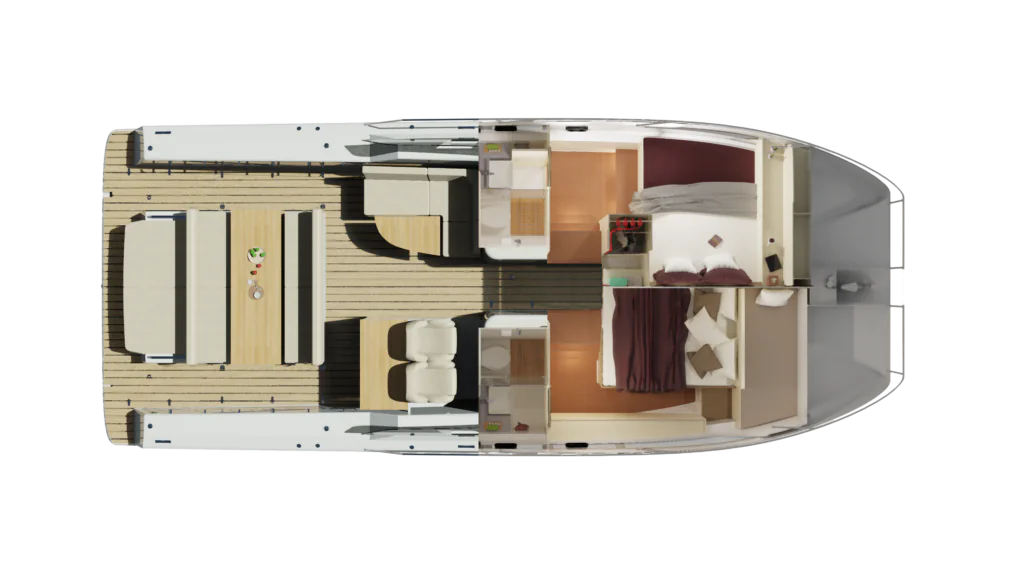
Significantly improved fuel consumption
Due to their reduced displacement and wetted surface area power catamarans are impressively efficient. The wider monohull bows create a large bow wake and greater resistance, which require more HP to get onto a plane. Not only does this burn more fuel, but also enables a catamaran to get onto a plane under just one motor. This is a significant safety advantage, enabling a boat with only one working engine to return to shore before dark rather than limping home at below planing speeds. The ability to plane at lower RPMs enables cruisers not wanting to travel at groundbreaking speeds to achieve highly efficient low-speed planning. Vastly expanding their cruising ground while not breaking the bank nor taking all day to get to the next anchorage. Learn more about power catamaran fuel consumption HERE>>
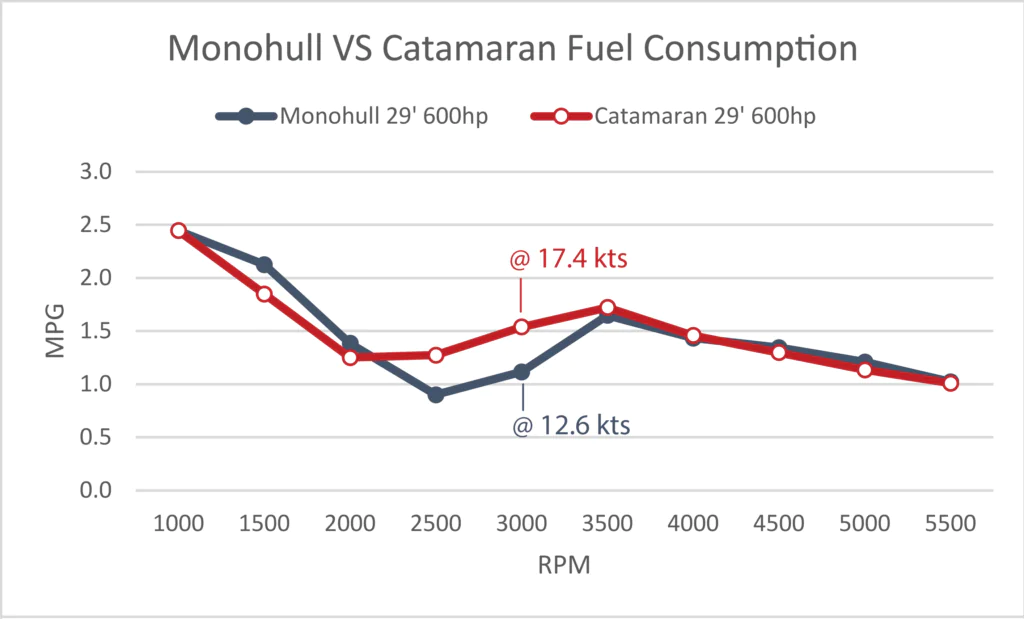
Drastically improved close-quarter maneuvering: A large separation between the port and starboard engine drastically improves close-quarters maneuvering. This enables a power catamaran to literally rotate within its own waterline length by simply putting one engine in reverse, and one in forward. Add a joystick control and you’re in command of one of the easiest boats that you will ever dock.
Disadvantages of Power Catamarans
Despite the significant benefits gained by the power catamaran, there are also a few unusual traits associated with powercats:
- Outward banking
- Snaking at anchor
- Tunnel-slap
- Unusual appearance
Outward banking
When making sharp turns a monohull will bank (roll) into the turn. A catamaran, on the other hand, due to its increased stability and righting moment will actually bank slightly outward. If coming from a monohull background, initially this sensation will feel unusual. However, If you have no prior expectations regarding the outward bank offers, no benefits or disadvantages over the inward bank.
Snaking at anchor
Due to the power catamaran’s wide beam and asymmetry, when at anchor a shifting breeze will cause the vessel to turn to port and starboard in a snakelike movement. If the wind has some strength and continues to shift, this movement can become uncomfortable. We, therefore, recommend attaching an anchor bridle whenever anchoring which completely eradicates this effect.
Tunnel-slap
In certain conditions, catamarans can experience tunnel slap. This is where a wave passing under the tunnel rises up and slaps the wingdeck surface causing a thud or slapping sound. This effects different catamaran designs in various ways depending on whether they are of displacement or planning type. A displacement catamaran requires a high wingdeck to overcome the wave crest heights in order to ride over the top of the waves. Planning catamarans, on the other hand, should have narrower and shallower tunnels. This forces a compressed air mixture through the tunnel, creating a cushioning and lifting effect lifting the catamaran above the surface of the water with intensity increasing as speed increases.
Unusual appearance
When asked, many monohull owners claim they do not like the unusual appearance of a power catamaran. Whilst styling preference is subjective, at Makai we have worked hard to design a power catamaran that delivers all of the benefits of a catamaran. Whilst doing so with attractive and unmistakable styling.
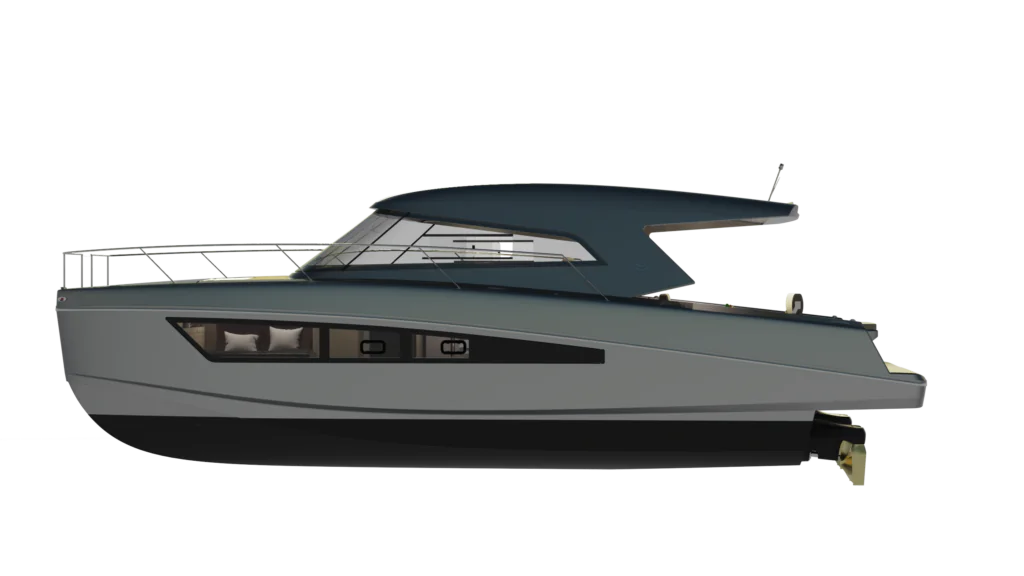
CONCLUSION: Power Catamaran or Monohull?
Whilst each have their own advantages and disadvantages the final choice is completely down to personal preference. Clearly, we are die hard catamaran believers, but we also believe that what is most important above all else is just getting outside and on the water, having fun and being safe. So, when you find the boat that does all of the right things for you, go for it!




